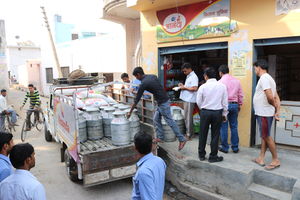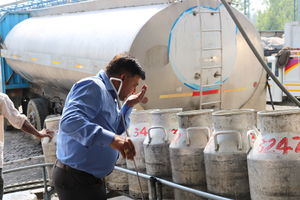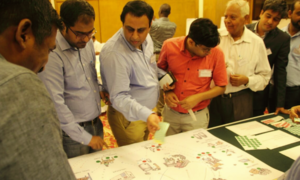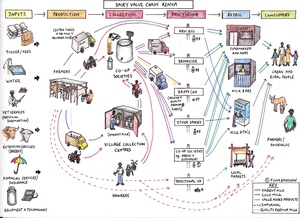Clean Energy Solutions for Milk Cooling in India and Kenya
Why is cooling important?
In low-income countries, smallholder farmers produce most of the milk on the market, and milk is one of the few commodities that can be produced even by the landless (FAO, 2017) . Selling surplus milk provides these farmers with much needed income.
With its combination of water, sugars, protein and minerals, milk at ambient temperature provides an ideal medium for bacterial growth. While some bacteria are harmless, raw milk can be a vector for infectious diseases, and studies have shown that it often contains pathogens such as Brucellosis and E. coli. One study which sampled raw milk on the Tanzanian market concluded it was “hazardous for human consumption” (Swai & Schoonman, 2011). Cooling milk slows down bacterial growth, reducing spoilage and therefore increasing farmer income, and also ensuring the milk is safe for consumers.
In both Kenya and India, farmers tend not to own their own cooling facilities. In India, however, procurement of milk organised by cooperatives and private dairies in the formal value chain is highly efficient, with the result that morning as well as evening milk reaches chillers in village collection centres within 3.5 hours after milking. Cooling is an energy intensive process, however, and maintaining an extensive network of collection facilities which frequently rely on diesel generators to back up the unreliable electricity grid imposes a significant financial burden on the cooperatives and private dairies. In Kenya, transporting the milk to collection centres with cooling facilities generally takes longer than 3.5 hours, and collection centres are open only in the morning. Evening milk needs to be consumed on-farm, sold to neighbours or informal traders, or processed into more durable dairy products to prevent it from spoiling overnight. Though informal traders sometimes offer higher prices than formal dairies, they do not guarantee farmers a steady income or offer additional support (feed, veterinary services, advice) and do not carry out quality control of the milk (Ter Heegde & Cok, 2015). Formal cooperatives and dairies running networks of collection centres with cooling in Kenya face the same financial burden as those in India, due to high costs for back-up electricity when the grid fails (Sims et al. 2017). Additionally, large parts of Kenya are still off-grid.
The successful application of clean energy cooling technology in the milk value chain therefore has the potential to improve the quality and increase the quantity of milk sold into the formal market, increasing the income of smallholder farmers and improving food safety for consumers. It can also provide opportunities for growth for businesses providing clean energy solutions.
Of course, cooling is not the only potential application for clean energy in milk value chains. Solar water heaters can provide affordable and plentiful hot water for cleaning equipment on farm and in collection centres, reducing the risk of contamination of the milk in the first place. Clean energy solutions can also be used to power heating and industrial processes in processing plants, and to cool dairy products in kiosks and other retailers, thereby lowering prices and reducing the carbon footprint of the dairy sector as a whole.
What are the challenges?
What are the main barriers to the update of renewable energy solutions for cooling in milk value chains?
In both India and Kenya, milk is collected at village collection points and then aggregated at larger centres. The main difference between the two countries lies in the efficiency with which milk is transported from the farm to the nearest collection centre. In India, milk is collected twice daily and spends little time in transit, leading to low levels of wastage – in fact, milk losses are said to be below 1% [1]. In Kenya, milk is only collected once a day in the morning, and it spends much longer in transit, leading to much higher levels of wastage. Actual numbers are disputed, and post-harvest losses have been quoted to be up to 10% in the literature and up to 50% in stakeholder discussions - see details about this data gap below (Muriuki, 2003; Sims et al. 2015; [2]. In Kenya, then, the main opportunity to strengthen the formal milk value chain is to introduce clean energy solutions for cooling at the farm and village collection level, whereas in India, farmers’ incomes would benefit from the displacement of conventional energy sources by clean energy sources and energy efficiency measures at the collection centre and processing level.
In order to introduce clean energy solutions in these value chains, the following barriers need to be overcome:
- High upfront cost of technology combined with a lack of financing mechanisms for clean energy: At the level of aggregated milk collection centres or processing plants, procurement often requires a tendering process selecting the cheapest offer – this makes it difficult for dairies and cooperatives to invest into modern, sustainable cooling solutions. In Kenya, where chilling at production stage has the most potential to improve the quality and increase the quantity of milk on the formal market, the farmers themselves would have to invest in renewable technology. Due to the small scale of their operations (most dairy farmers have 2 or 3 cows, producing up to 15 L of milk a day each of which up to 50% is consumed on-farm), they cannot benefit from economies of scale. Some Kenyan dairy farmers have been able to buy refrigerators with loans provided by their cooperative, but such financing products are not yet widely available or sought after by farmers.
- Lack of reliable data regarding milk losses in Kenya: The numbers in Kenya describing milk losses are very disputed, and hard to track down – besides data gaps, the definition of “losses” is not clear cut and may include unmarketed milk, self-consumption, forced consumption as well as “down the drain” wasted milk.
- Lack of nationwide premiums for cold milk in Kenya: though some dairies pay a premium for milk that arrives to their collection centres already chilled, most do not. This reduces the financial incentive for farmers to invest in cooling technology.
- Consumers in the informal market prefer warm milk: Kenyan farmers sell up to 80% of their milk on the informal market. Consumers buying from the informal market prefer warm milk, because warm milk that is not spoilt must be fresh. They distrust chilled milk because they assume it must be less fresh (Ter Heegde & Cok, 2015).
- Lack of awareness of available technology among farmers, dairies and cooperatives
- Relevant policies and regulations do not exist or are not enforced: even where food safety regulations exist, requiring the total bacterial count (TBC) in milk to be below a certain threshold, they are not consistently enforced (especially in Kenya) (Lange et al., 2016). In the informal markets, where quality testing is not carried out, enforcement is even more challenging than in the formal markets.
- The size of the informal market: as mentioned above, up to 80% of Kenyan milk is sold by farmers to informal traders rather than cooperatives or dairies (Sims et al. 2017). In India, the share of the informal market is similar (~70%) (NDDB, 2017). In Kenya, cooling facilities are rare or non-existent in the informal market while in India larger informal actors sometimes run BMCs (Bulk Milk Chillers). The informal market also lacks quality checks, which reduces the incentive for improvements. Smallholder farmers who are not connected to a cooperative or dairy are also much more difficult to reach with awareness raising interventions.
- Other factors than temperature affect the quality of the milk: though cooling helps preserve milk quality by slowing down bacterial growth, it does not kill bacteria or halt their growth altogether. Milk from healthy cows typically has very low bacterial counts, but poor animal handling and hygienic practices cause it to be contaminated soon after milking. A study in Zambia found that, once milk is contaminated and after an initial slow-growth phase due to milk’s antibacterial properties, bacteria start growing very quickly even if the milk is refrigerated (Knight-Jones et al., 2016). Milk is also often adulterated with water to increase its volume. This means that only modest gains in milk quality can be made by cooling interventions alone, and supports the argument for the deployment of other awareness raising efforts and the deployment of further clean energy solutions in the value chain, such as solar water heaters for equipment cleaning at farm level.
Other challenges faced by dairies in India and Kenya
- Low milk yields per cow: Milk supply on the Indian and Kenyan markets is struggling to keep up with growing demand (Punjabi, 2007). As can be seen on the value chain map, supply is not curtailed to a significant extent by spoilage of milk. Rather, it is limited mostly by low yields. At about 4 to 7 litres a day, the average milk yield per cow in India is only 15 to 30% of that in high-income countries (KPMG-Consultancy, 2017). In Kenya, yields per cow are similar. Causes of this low yield include the use of non-optimal, indigenous breeds of cattle, a lack of veterinary support and a resulting high incidence of foot and mouth disease (which in India leads to an estimated annual loss of USD 3 billion worth of meat and dairy products annually (Press Information Bureau of the Government of India, 2016) and a frequent lack of appropriate fodder and water for the animals. On top of this, milk supply is highly seasonal in both countries: in Kenya, supply decreases by as much as 50% in the dry season (Food Business Africa, 2014), and in India, milk supply to the formal market drops sharply in the festival season, when close to 100% of marketable milk is diverted to informal channels (360degree, 2017).
- High cost of procurement: Procurement of milk from rural areas is expensive because of long distances and poor roads which lengthen travel times (Food Business Africa, 2014).
- High cost of production due to fragmented landscape: Another issue faced by Indian and Kenyan dairies is the relatively high cost of production and procurement (Food Business Africa, 2014). The fragmented producer landscape requires the collection of relatively small amounts of milk from many collection points, reduces economies of scale and increases processing costs per unit. Small dairies are less likely to have access to the knowledge and capital required to invest in modern technology for their cooling facilities and processing plants. Enhancing access to finance for these dairies, to allow them to invest in energy efficient and clean energy solutions, could greatly improve energy efficiency and reduce CO2 emissions in the sector. This would also lead to reduced costs, which would allow cooperatives and dairies to pay higher prices to farmers and/or reduce competition from cheap imported milk powder.
Knowledge gaps identified
The following knowledge gaps were marked high in both importance and urgency by the stakeholders during the two stakeholder workshops (Delhi, September 2017 and Nairobi, October 2017)[3]. These gaps could be addressed through awareness raising and capacity building:
Kenya:
- Lack of national statistics on milk production volume or percentage of spoilage and therefore lack of information on the scale of the problem
- Lack of awareness of financing options for cooling technology and possible co-benefits of energy savings
- Lack of awareness of available cooling technology, especially among women
India:
- Business cases and opportunities for conversion to solar power at plant scale not available/ shared
- Dairy unions/companies and independent BMC operators unaware of recent reductions in cost of solar technology and of the potential benefits of solar powered chilling options
- Village level staff and technicians not trained in installing/maintaining solar-powered BMCs
Cold chains in India and Kenya
India
As can be seen on the value chain map, the Indian cold chain for dairy is well-developed in the formal market. In fact, chilling facilities are common in many Indian food value chains, and just 1% are used for dairy and meat (a majority are used to store potatoes). Milk typically reaches cooling facilities within 3.5 hours after milking, and losses due to insufficient cooling at this stage are minimal.
Dairy businesses and cooperatives use either loose Bulk Milk Chillers (BMCs) or conventional cooling systems in fixed Milk Collection Centres (MCCs) to cool milk. MCCs tend to have larger capacities than BMCs and chill milk faster. BMCs on the other hand are more mobile and can be placed where demand for chilling is highest.
Though the Indian system of procuring and chilling milk is effective, operating costs are high. This is partly due to the unreliability of the electricity grid, which leads to the frequent use of back-up batteries or diesel generators. Moreover, many of the chilling facilities use outdated, inefficient technology. Significant cost savings and CO2 emissions reductions could be achieved through the deployment of energy efficient technology combined with renewable energy solutions in milk collection centres.
Whereas in Kenya the majority of milk losses occur at the early production stages at the value chain, before the milk reaches a collection centre (Sims et al., 2015), in India most milk is lost after it leaves the plant, i.e. on the way to or on the market. Many retailers have inadequate cooling facilities, and this could be another entry point for clean energy technologies.
Kenya
In Kenya, the poor cold chain is a recognised problem for the dairy sector (Sims et al., 2017). As can be seen on the value chain map, the cold chain is non-existent in the informal dairy market, and even in the formal market some milk is not cooled until it reaches a processing plant.
Cooling at farm level is rare, since most farmers lack reliably electricity access and refrigerators require a sizeable upfront investment. Some pilot projects have provided farmers with solar-powered refrigerators. Besides reductions in spoilage of their own milk, farmers with refrigerators reported a number of other benefits of this technology: it allowed them to charge cell phones and charge neighbours to do the same, it allowed them to buy neighbours’ evening milk cheaply before selling it on to the cooperative the next morning, and it allowed them to cool vegetables and drinking water, space permitting. On the other hand, farmers also pointed out additional labour required to operate e.g. a biogas digester, and the difficulties in securing maintenance and spare parts when required.
Village collection centres generally lack cooling equipment, and in fact are little more than holding areas where farmers can drop off their milk for transport to the central collection centres run cooperatives. Many of these do have cooling tanks, a significant number of which were issued by the government. A field survey found that a large number of these tanks, however, are no longer functional or are not connected to the grid. Cooperatives tend to lack the capacity to maintain and repair the tanks and/or find the cost of electricity too high. As mentioned before, cooling milk also makes it more difficult to sell directly to consumers who prefer their milk at ambient temperature. Where the cooling tanks are in use, frequent power cuts either reduce their functionality or require back-up by expensive and polluting diesel generators.
In order to encourage cooling at the collection stage, some processors pay a premium for milk that is delivered cold. To improve the cold chain in a sustainable manner, such premiums must become more widespread, and farmers need to be made aware of them.
About the project
The project ‘Business Cases for Milk Cooling’, funded by GIZ project Powering Agriculture and implemented by REEEP, analysed experiences and data from milk value chains in East Africa and South Asia, tapping into case studies and ground research in Kenya and selected states in India (Rajasthan and Uttar Pradesh). The primary aims of the project were to identify entry points for clean energy solutions to enhance the sustainability and resilience of the milk value chains and to enable south-south knowledge exchange between stakeholders in India and Kenya.
A project brochure highlighting important findings and graphics can be downloaded at REEEP.
References
- ↑ Mr. Singh of Payaas Dairy, Meeting with REEEP in Jaipur 2017 / National Dairy Development Board, Meeting with REEEP in Delhi 2017 / Mr Kalyan Bhadra of 360° Consultancy, Meeting with REEEP 2017; data verified by participants at stakeholder workshop in Delhi, September 2017
- ↑ Quotes on milk losses collected from various dairy stakeholder in Kenya, such as New KCC Dairy, Winrock international, Happy Cow dairy, Hohenheim University and discussed at stakeholder workshop in Nairobi, October 2017
- ↑ Workshops to present and discuss findings, challenges and opportunities with dairy stakeholders (including: government/ministry, dairy associations, finance sector, NGOs and development agencies, cooperatives and private sector representatives): (1) India Habitat Center, Lodhi Road Quarters in New Delhi on September 19th, 2017 / (2) Fairview Hotel in Nairobi on October 10th, 2017
360degree-Consultancy. (2017, May). (B. H. Denise Recheis, Interviewer)
FAO. (2017). Dairy production and products. Retrieved from Food and Agriculture Organization of the United Nations: http://www.fao.org/agriculture/dairy-gateway
Food Business Africa. (2014). The Dairy Industry in Kenya. Retrieved from http://www.foodbusinessafrica.com/the-dairy-industry-in-kenya/
Kasirye, D. F. (2003). Milk and Dairy Products, Post-harvest Losses and Food Safety in Sub-Saharan Africa and the Near East. FAO: http://www.fao.org/fileadmin/templates/ags/docs/dairy/P1assessmentuganda.pdf
Knight-Jones, T., Hang'ombe, M., Songe, M., Sinkala, Y., & Grace, D. (2016). Microbial Contamination and Hygiene of Fresh Cow’s Milk Produced by Smallholders in Western Zambia. International Journal of Environmental Research and Public Health: http://www.mdpi.com/1660-4601/13/7/737/htm
Lange, B., Priesemann, C., Geiss, M., & Lambrecht, A. (2016). Promoting Food Security and Safety via Cold Chains. Eschborn: Deutsche Gesellschaft für Internationale Zusammenarbeit (GIZ) GmbH: https://www.giz.de/expertise/downloads/giz2017-en-food-security-cold-chains.pdf
National Dairy Development Board. (2017, May). (B. Harvey, & D. Recheis, Interviewers)
Press Information Bureau of the Government of India. (2016, August 9). ‘FMD Mukt Bharat’ in next few years . Retrieved from http://pib.nic.in/newsite/PrintRelease.aspx?relid=148556
R. Sims, A. Flammini, M. Puri, S. Bracco. (2017). Costs and benefits of clean energy technologies in the milk, vegetable and rice value-chains. FAO: http://www.fao.org/3/a-i5125e.pdf
Swai, E., & Schoonman, L. (2011). Microbial quality and associated health risks of raw milk marketed in the Tanga region of Tanzania. Asian Pacific Journal of Tropical Biomedicine: https://www.ncbi.nlm.nih.gov/pmc/articles/PMC3609189/
Ter Heegde, F., & Cok, B. (2015). Milk Chilling with Biogas. SNV Netherlands Development Organisation: http://www.snv.org/project/milk-chilling-biogas-kenya-tanzania-and-zambia
Lange, B., Priesemann, C., Geiss, M., & Lambrecht, A. (2016). Promoting Food Security and Safety via Cold Chains. Eschborn: Deutsche Gesellschaft für Internationale Zusammenarbeit (GIZ) GmbH: https://www.giz.de/expertise/downloads/giz2017-en-food-security-cold-chains.pdf
National Dairy Development Board (NDDB). (2017, May). (B. Harvey, & D. Recheis, Interviewers)
Press Information Bureau of the Government of India. (2016, August 9). ‘FMD Mukt Bharat’ in next few years . Retrieved from http://pib.nic.in/newsite/PrintRelease.aspx?relid=148556
R. Sims, A. Flammini, M. Puri, S. Bracco. (2017). Costs and benefits of clean energy technologies in the milk, vegetable and rice value-chains. FAO: http://www.fao.org/3/a-i5125e.pdf
Swai, E., & Schoonman, L. (2011). Microbial quality and associated health risks of raw milk marketed in the Tanga region of Tanzania. Asian Pacific Journal of Tropical Biomedicine: https://www.ncbi.nlm.nih.gov/pmc/articles/PMC3609189/
Ter Heegde, F., & Cok, B. (2015). Milk Chilling with Biogas. SNV Netherlands Development Organisation: http://www.snv.org/project/milk-chilling-biogas-kenya-tanzania-and-zambia

























